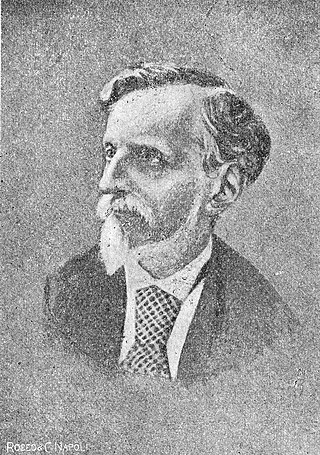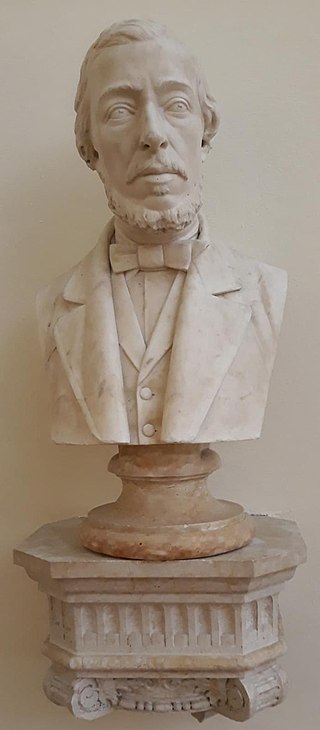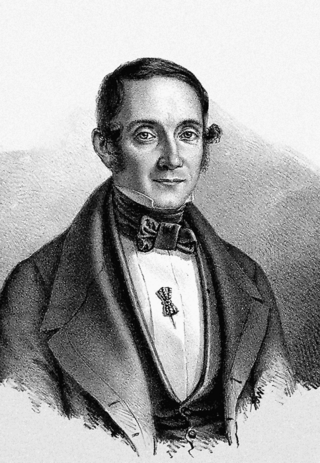
Giuseppe De Notaris (18 April 1805 – 22 January 1877) was an Italian botanist generally known for his work with cryptogams native to Italy.

Giuseppe De Notaris (18 April 1805 – 22 January 1877) was an Italian botanist generally known for his work with cryptogams native to Italy.
Born 18 April 1805, in Milan, he studied medicine at the University of Pavia, obtaining his medical degree in 1830. Having developed an interest in botany, by 1832 he had abandoned the field of medicine. In 1836, he accepted an assignment at the botanical garden in Turin, and a few years later, was named professor of botany and director of the botanical garden at the University of Genoa (1839). In 1872, he was appointed chair of botany at the University of Rome. [1] Together with Francesco Baglietto, Vincenzo de Cesati and Giuseppe Gabriel Balsamo-Crivelli he edited several exsiccata series. [2]
In the field of mycology, he proposed the fungi family Hypocreaceae (1845). [3] With Antonio Bey Figari (1804–1870), he described numerous species from the family Poaceae. [4] With Figari, he was the binomial co-author of the grass genus Schistachne (synonym Stipagrostis ). [5] Organisms with the specific epithet of notarisiana commemorate his name. [6]

Antonio José Cavanilles was a leading Spanish taxonomic botanist, artist and one of the most important figures in the 18th century period of Enlightenment in Spain.

Pier Andrea Saccardo was an Italian botanist and mycologist. He was also the author of a color classification system that he called Chromotaxia. He was elected to the Linnean Society in 1916 as a foreign member. His multi-volume Sylloge Fungorum was one of the first attempts to produce a comprehensive treatise on the fungi which made use of the spore-bearing structures for classification.

Giorgio Jan was an Italian taxonomist, zoologist, botanist, herpetologist, and writer. He is also known as Georg Jan or Georges Jan. He was the first director of the natural history museum at Milan.

Giuseppe Gabriel Balsamo-Crivelli was an Italian naturalist.
Johannes Conrad Schauer was a botanist interested in spermatophytes. He was born in Frankfurt am Main and attended the gymnasium of Mainz from 1825 to 1837. For the next three years he worked at the Hofgarten of Würzburg. Schauer then gained a position as assistant at the botanical garden at Bonn where he worked until 1832 when he was placed in charge of the botanic garden in Breslau, with C.G. Nees. He gained the degree of Doctor of Philosophy at the University of Erlangen-Nuremberg 1835 and was appointed professor of botany at the University of Greifswald from 1843 until his death in 1848.

Vincenzo de Cesati (1806–1883) was an Italian botanist from Milan.

George Samuel Perrottet, also known as Georges Guerrard-Samuel Perrottet, was a botanist and horticulturalist from Praz, in the commune of Vully-le-Bas, today Mont-Vully, Switzerland. After expeditions in Africa and Southeast Asia where he collected plant and animal specimens, he worked in French Pondicherry, India, where he established a botanical garden. He took a special interest in plants of economic importance and was involved in the activities of acclimatisation societies in the various colonies of France. Many of his zoological specimens, sent to museums in France, were examined by other naturalists and named after him.

Mariano Lagasca y Segura (1776–1839), also known as Mariano la Gasca, was a Spanish botanist, writer and doctor. He was the director of the Real Jardín Botánico de Madrid.
Domenico Viviani was an Italian botanist and naturalist.

Giuseppe Giovanni Antonio Meneghini was an Italian botanist, geologist and paleontologist.

Abramo Bartolommeo Massalongo was an Italian paleobotanist and lichenologist. He was born in Tregnago in the Province of Verona and took a great interest in botany as a young man. Massalongo joined the faculty of medicine at the University of Padua in 1844. Along with Gustav Wilhelm Körber, he founded the "Italian-Silesian" school of lichenology. He also collaborated with Martino Anzi. He was the husband of Maria Colognato and the father of hepaticologist Caro Benigno Massalongo. He also worked in the scientific field of herpetology. Massalongo edited the exsiccata Lichenes Italici Exsiccati (1855-1856). In 1859 his Catalogo dei rettili delle province venete was published in Venice.
Ignaz Friedrich Tausch was a Bohemian botanist.

Giuseppe Giacinto Moris was an Italian botanist known for investigations of flora native to Sardinia.
Antonio Bey Figari was an Italian pharmacist and naturalist.
Henry Hurd Rusby (1855–1940) was an American botanist, pharmacist and explorer. He discovered several new species of plants and played a significant role in founding the New York Botanical Garden and developing research and exploration programs at the institution. He helped to establish the field of economic botany, and left a collection of research and published works in botany and pharmacology.

Giuseppe Moretti was an Italian botanist.

Giuseppe Cuboni was an Italian botanist and agronomist, known for his pioneer work in the field of plant pathology.

Roberto de Visiani (1800-1878) was a Dalmatian Italian botanist, naturalist and scholar. He is seen as one of the fathers of modern botany in Italy.
Elisabetta Fiorini Mazzanti was an Italian botanist and writer. She was known for her work in bryology and algae. In scientific literature, she is referred to by the abbreviation Fior.-Mazz.
CavaliereCarlo Antonio Fornasini was an Italian ivory trader and amateur field naturalist who worked in Mozambique. He collected numerous specimens of animals, insects and plants, and presented them to the Academy of Sciences of the Institute of Bologna in his home city for scientific study. He is remembered for having had several taxa named in his honour during his lifetime.